Complexity of Diseases: Interrelationships, Case Study, and Nursing
VerifiedAdded on 2020/03/01
|12
|3361
|97
Report
AI Summary
This report delves into the intricate interrelationships between complexity, chronicity, and co-morbidity in healthcare. It examines the pathophysiology of COPD and osteoarthritis, highlighting their connection to cigarette smoking and lifestyle factors. The report analyzes a case study of a patient with COPD and osteoarthritis, discussing the symptoms, the interactions between the conditions, and the rationale behind the prescribed medications (Symbicort, Spiriva, Salbutamol, and Paracetamol). It emphasizes the importance of critical thinking in nursing care, considering the patient's symptoms, weight gain, and the impact of these factors on mobility and overall health. The report provides insights into how healthcare professionals can effectively manage patients with multiple chronic conditions, offering valuable information for students on Desklib.
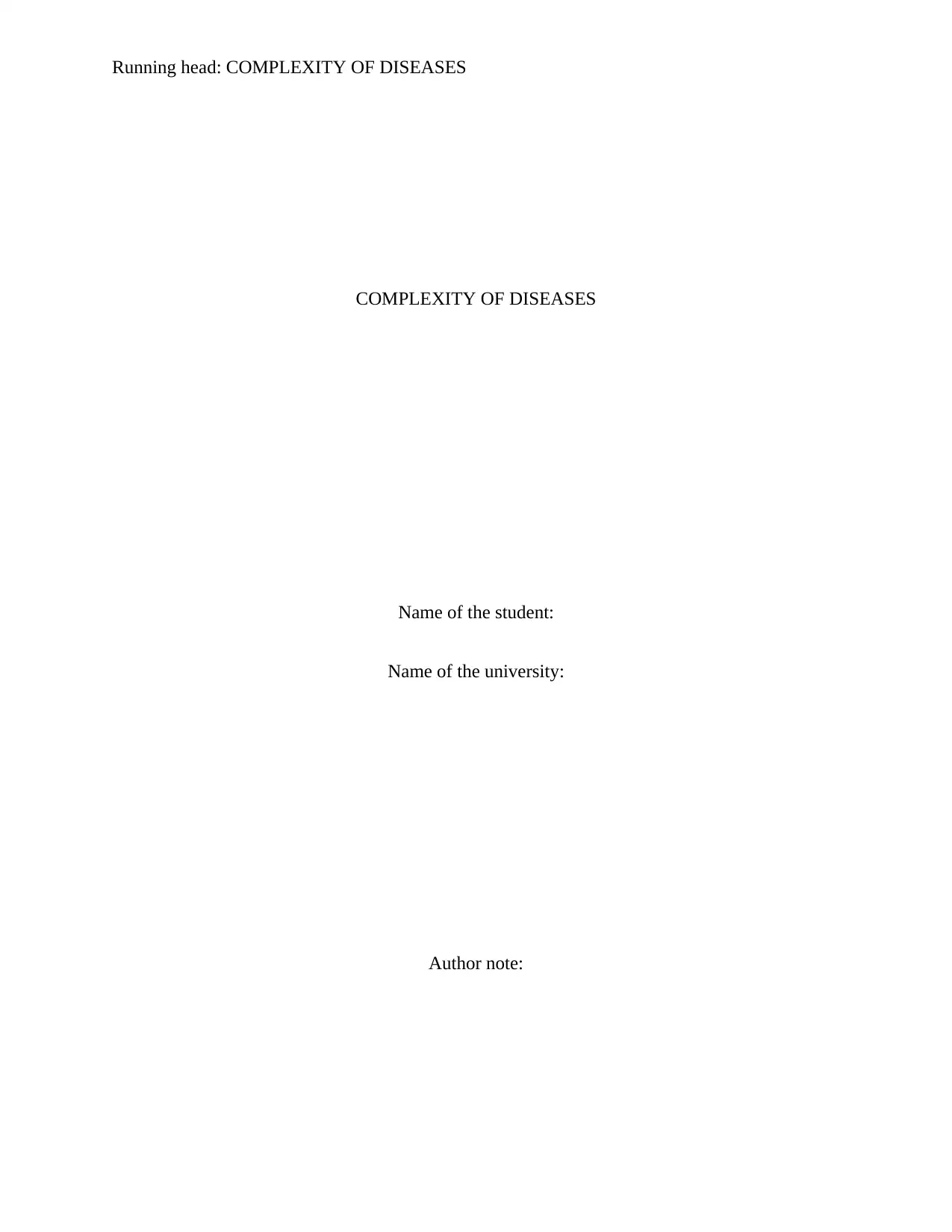
Running head: COMPLEXITY OF DISEASES
COMPLEXITY OF DISEASES
Name of the student:
Name of the university:
Author note:
COMPLEXITY OF DISEASES
Name of the student:
Name of the university:
Author note:
Paraphrase This Document
Need a fresh take? Get an instant paraphrase of this document with our AI Paraphraser
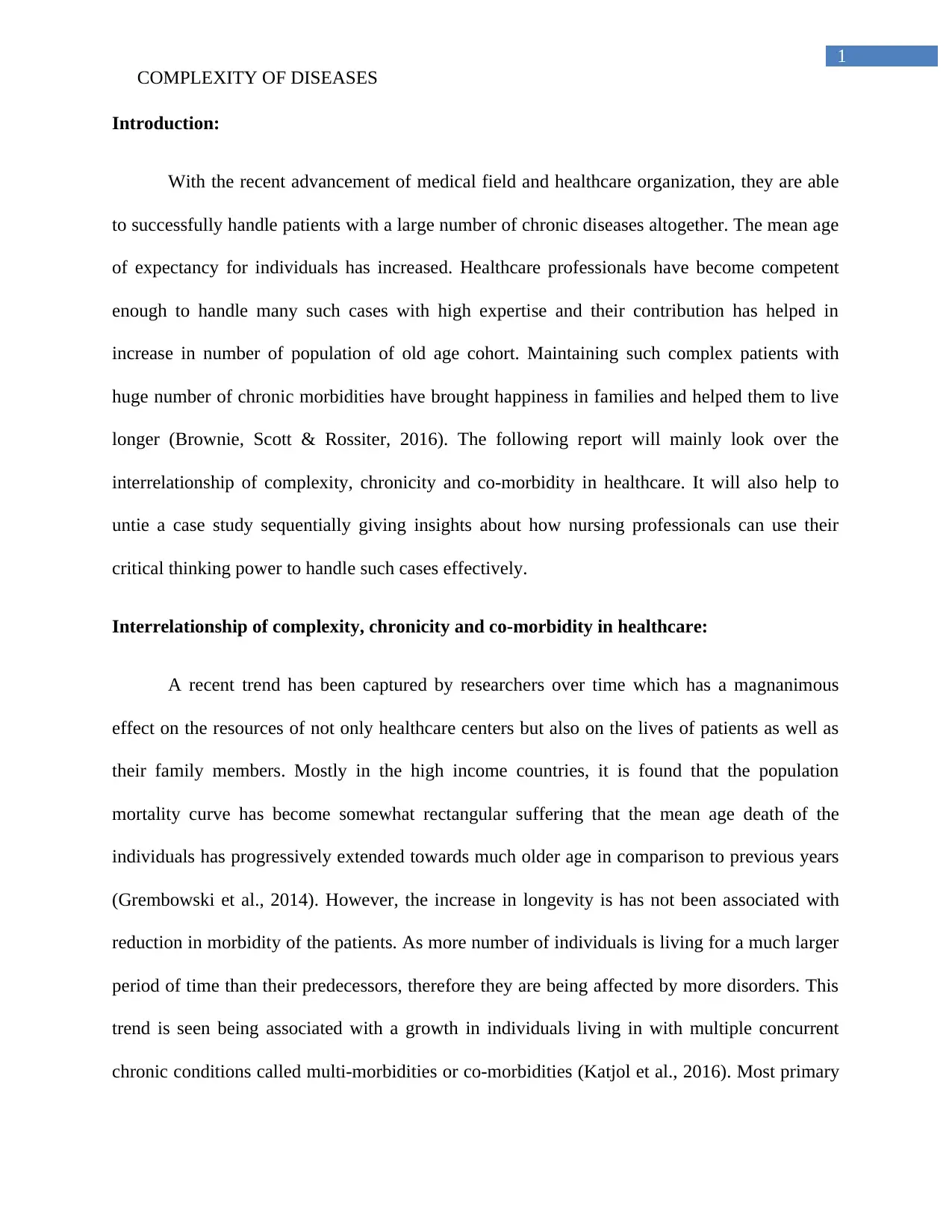
1
COMPLEXITY OF DISEASES
Introduction:
With the recent advancement of medical field and healthcare organization, they are able
to successfully handle patients with a large number of chronic diseases altogether. The mean age
of expectancy for individuals has increased. Healthcare professionals have become competent
enough to handle many such cases with high expertise and their contribution has helped in
increase in number of population of old age cohort. Maintaining such complex patients with
huge number of chronic morbidities have brought happiness in families and helped them to live
longer (Brownie, Scott & Rossiter, 2016). The following report will mainly look over the
interrelationship of complexity, chronicity and co-morbidity in healthcare. It will also help to
untie a case study sequentially giving insights about how nursing professionals can use their
critical thinking power to handle such cases effectively.
Interrelationship of complexity, chronicity and co-morbidity in healthcare:
A recent trend has been captured by researchers over time which has a magnanimous
effect on the resources of not only healthcare centers but also on the lives of patients as well as
their family members. Mostly in the high income countries, it is found that the population
mortality curve has become somewhat rectangular suffering that the mean age death of the
individuals has progressively extended towards much older age in comparison to previous years
(Grembowski et al., 2014). However, the increase in longevity is has not been associated with
reduction in morbidity of the patients. As more number of individuals is living for a much larger
period of time than their predecessors, therefore they are being affected by more disorders. This
trend is seen being associated with a growth in individuals living in with multiple concurrent
chronic conditions called multi-morbidities or co-morbidities (Katjol et al., 2016). Most primary
COMPLEXITY OF DISEASES
Introduction:
With the recent advancement of medical field and healthcare organization, they are able
to successfully handle patients with a large number of chronic diseases altogether. The mean age
of expectancy for individuals has increased. Healthcare professionals have become competent
enough to handle many such cases with high expertise and their contribution has helped in
increase in number of population of old age cohort. Maintaining such complex patients with
huge number of chronic morbidities have brought happiness in families and helped them to live
longer (Brownie, Scott & Rossiter, 2016). The following report will mainly look over the
interrelationship of complexity, chronicity and co-morbidity in healthcare. It will also help to
untie a case study sequentially giving insights about how nursing professionals can use their
critical thinking power to handle such cases effectively.
Interrelationship of complexity, chronicity and co-morbidity in healthcare:
A recent trend has been captured by researchers over time which has a magnanimous
effect on the resources of not only healthcare centers but also on the lives of patients as well as
their family members. Mostly in the high income countries, it is found that the population
mortality curve has become somewhat rectangular suffering that the mean age death of the
individuals has progressively extended towards much older age in comparison to previous years
(Grembowski et al., 2014). However, the increase in longevity is has not been associated with
reduction in morbidity of the patients. As more number of individuals is living for a much larger
period of time than their predecessors, therefore they are being affected by more disorders. This
trend is seen being associated with a growth in individuals living in with multiple concurrent
chronic conditions called multi-morbidities or co-morbidities (Katjol et al., 2016). Most primary
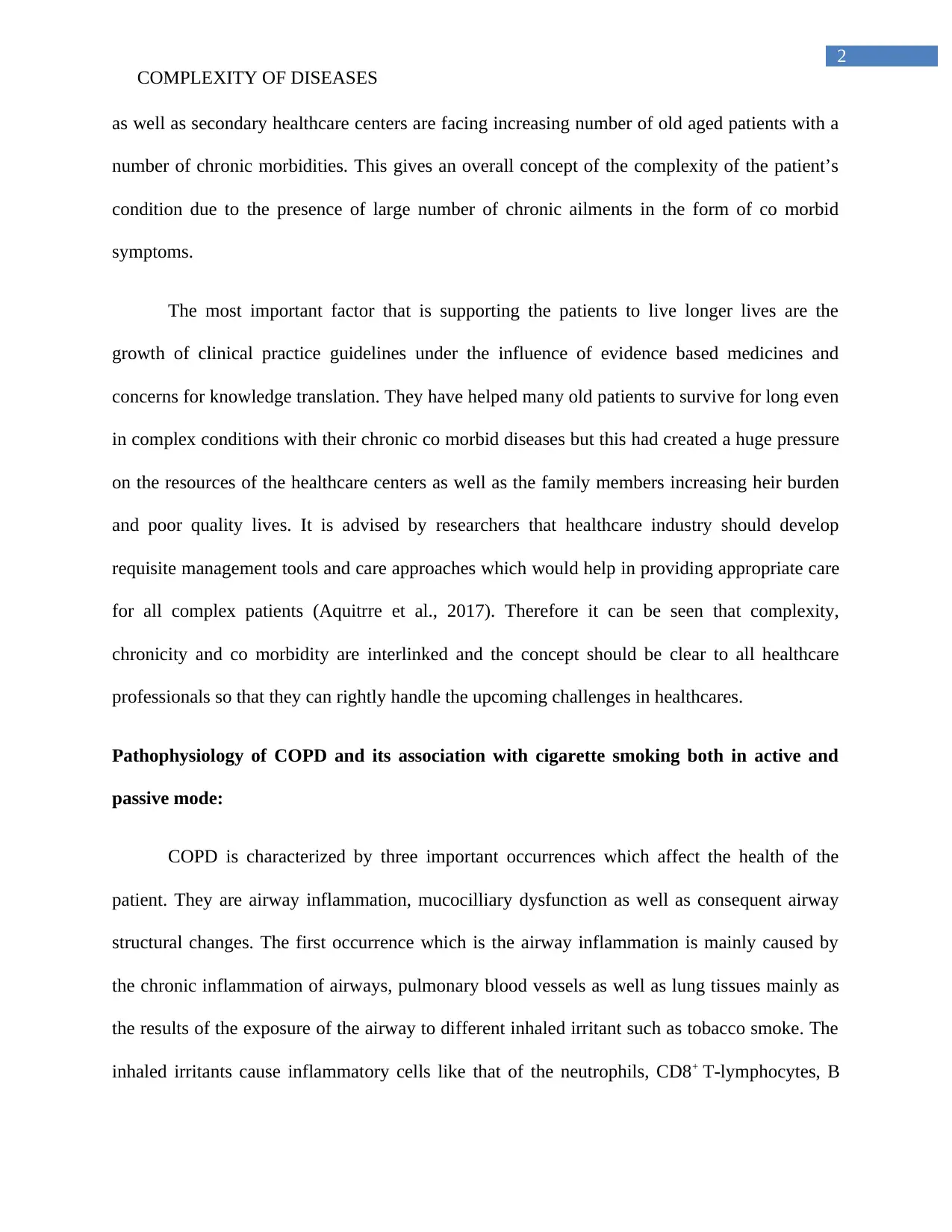
2
COMPLEXITY OF DISEASES
as well as secondary healthcare centers are facing increasing number of old aged patients with a
number of chronic morbidities. This gives an overall concept of the complexity of the patient’s
condition due to the presence of large number of chronic ailments in the form of co morbid
symptoms.
The most important factor that is supporting the patients to live longer lives are the
growth of clinical practice guidelines under the influence of evidence based medicines and
concerns for knowledge translation. They have helped many old patients to survive for long even
in complex conditions with their chronic co morbid diseases but this had created a huge pressure
on the resources of the healthcare centers as well as the family members increasing heir burden
and poor quality lives. It is advised by researchers that healthcare industry should develop
requisite management tools and care approaches which would help in providing appropriate care
for all complex patients (Aquitrre et al., 2017). Therefore it can be seen that complexity,
chronicity and co morbidity are interlinked and the concept should be clear to all healthcare
professionals so that they can rightly handle the upcoming challenges in healthcares.
Pathophysiology of COPD and its association with cigarette smoking both in active and
passive mode:
COPD is characterized by three important occurrences which affect the health of the
patient. They are airway inflammation, mucocilliary dysfunction as well as consequent airway
structural changes. The first occurrence which is the airway inflammation is mainly caused by
the chronic inflammation of airways, pulmonary blood vessels as well as lung tissues mainly as
the results of the exposure of the airway to different inhaled irritant such as tobacco smoke. The
inhaled irritants cause inflammatory cells like that of the neutrophils, CD8+ T-lymphocytes, B
COMPLEXITY OF DISEASES
as well as secondary healthcare centers are facing increasing number of old aged patients with a
number of chronic morbidities. This gives an overall concept of the complexity of the patient’s
condition due to the presence of large number of chronic ailments in the form of co morbid
symptoms.
The most important factor that is supporting the patients to live longer lives are the
growth of clinical practice guidelines under the influence of evidence based medicines and
concerns for knowledge translation. They have helped many old patients to survive for long even
in complex conditions with their chronic co morbid diseases but this had created a huge pressure
on the resources of the healthcare centers as well as the family members increasing heir burden
and poor quality lives. It is advised by researchers that healthcare industry should develop
requisite management tools and care approaches which would help in providing appropriate care
for all complex patients (Aquitrre et al., 2017). Therefore it can be seen that complexity,
chronicity and co morbidity are interlinked and the concept should be clear to all healthcare
professionals so that they can rightly handle the upcoming challenges in healthcares.
Pathophysiology of COPD and its association with cigarette smoking both in active and
passive mode:
COPD is characterized by three important occurrences which affect the health of the
patient. They are airway inflammation, mucocilliary dysfunction as well as consequent airway
structural changes. The first occurrence which is the airway inflammation is mainly caused by
the chronic inflammation of airways, pulmonary blood vessels as well as lung tissues mainly as
the results of the exposure of the airway to different inhaled irritant such as tobacco smoke. The
inhaled irritants cause inflammatory cells like that of the neutrophils, CD8+ T-lymphocytes, B
⊘ This is a preview!⊘
Do you want full access?
Subscribe today to unlock all pages.

Trusted by 1+ million students worldwide
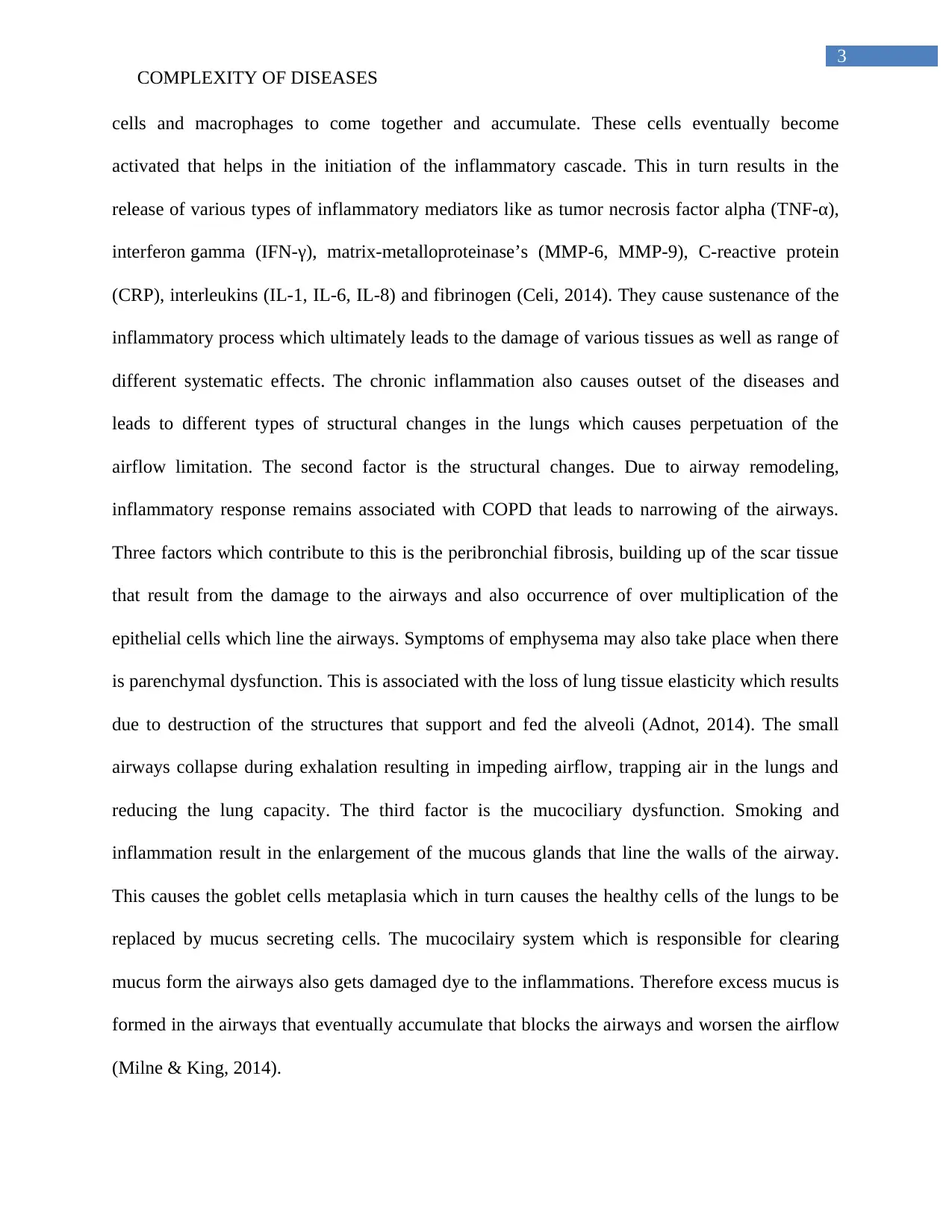
3
COMPLEXITY OF DISEASES
cells and macrophages to come together and accumulate. These cells eventually become
activated that helps in the initiation of the inflammatory cascade. This in turn results in the
release of various types of inflammatory mediators like as tumor necrosis factor alpha (TNF-α),
interferon gamma (IFN-γ), matrix-metalloproteinase’s (MMP-6, MMP-9), C-reactive protein
(CRP), interleukins (IL-1, IL-6, IL-8) and fibrinogen (Celi, 2014). They cause sustenance of the
inflammatory process which ultimately leads to the damage of various tissues as well as range of
different systematic effects. The chronic inflammation also causes outset of the diseases and
leads to different types of structural changes in the lungs which causes perpetuation of the
airflow limitation. The second factor is the structural changes. Due to airway remodeling,
inflammatory response remains associated with COPD that leads to narrowing of the airways.
Three factors which contribute to this is the peribronchial fibrosis, building up of the scar tissue
that result from the damage to the airways and also occurrence of over multiplication of the
epithelial cells which line the airways. Symptoms of emphysema may also take place when there
is parenchymal dysfunction. This is associated with the loss of lung tissue elasticity which results
due to destruction of the structures that support and fed the alveoli (Adnot, 2014). The small
airways collapse during exhalation resulting in impeding airflow, trapping air in the lungs and
reducing the lung capacity. The third factor is the mucociliary dysfunction. Smoking and
inflammation result in the enlargement of the mucous glands that line the walls of the airway.
This causes the goblet cells metaplasia which in turn causes the healthy cells of the lungs to be
replaced by mucus secreting cells. The mucocilairy system which is responsible for clearing
mucus form the airways also gets damaged dye to the inflammations. Therefore excess mucus is
formed in the airways that eventually accumulate that blocks the airways and worsen the airflow
(Milne & King, 2014).
COMPLEXITY OF DISEASES
cells and macrophages to come together and accumulate. These cells eventually become
activated that helps in the initiation of the inflammatory cascade. This in turn results in the
release of various types of inflammatory mediators like as tumor necrosis factor alpha (TNF-α),
interferon gamma (IFN-γ), matrix-metalloproteinase’s (MMP-6, MMP-9), C-reactive protein
(CRP), interleukins (IL-1, IL-6, IL-8) and fibrinogen (Celi, 2014). They cause sustenance of the
inflammatory process which ultimately leads to the damage of various tissues as well as range of
different systematic effects. The chronic inflammation also causes outset of the diseases and
leads to different types of structural changes in the lungs which causes perpetuation of the
airflow limitation. The second factor is the structural changes. Due to airway remodeling,
inflammatory response remains associated with COPD that leads to narrowing of the airways.
Three factors which contribute to this is the peribronchial fibrosis, building up of the scar tissue
that result from the damage to the airways and also occurrence of over multiplication of the
epithelial cells which line the airways. Symptoms of emphysema may also take place when there
is parenchymal dysfunction. This is associated with the loss of lung tissue elasticity which results
due to destruction of the structures that support and fed the alveoli (Adnot, 2014). The small
airways collapse during exhalation resulting in impeding airflow, trapping air in the lungs and
reducing the lung capacity. The third factor is the mucociliary dysfunction. Smoking and
inflammation result in the enlargement of the mucous glands that line the walls of the airway.
This causes the goblet cells metaplasia which in turn causes the healthy cells of the lungs to be
replaced by mucus secreting cells. The mucocilairy system which is responsible for clearing
mucus form the airways also gets damaged dye to the inflammations. Therefore excess mucus is
formed in the airways that eventually accumulate that blocks the airways and worsen the airflow
(Milne & King, 2014).
Paraphrase This Document
Need a fresh take? Get an instant paraphrase of this document with our AI Paraphraser
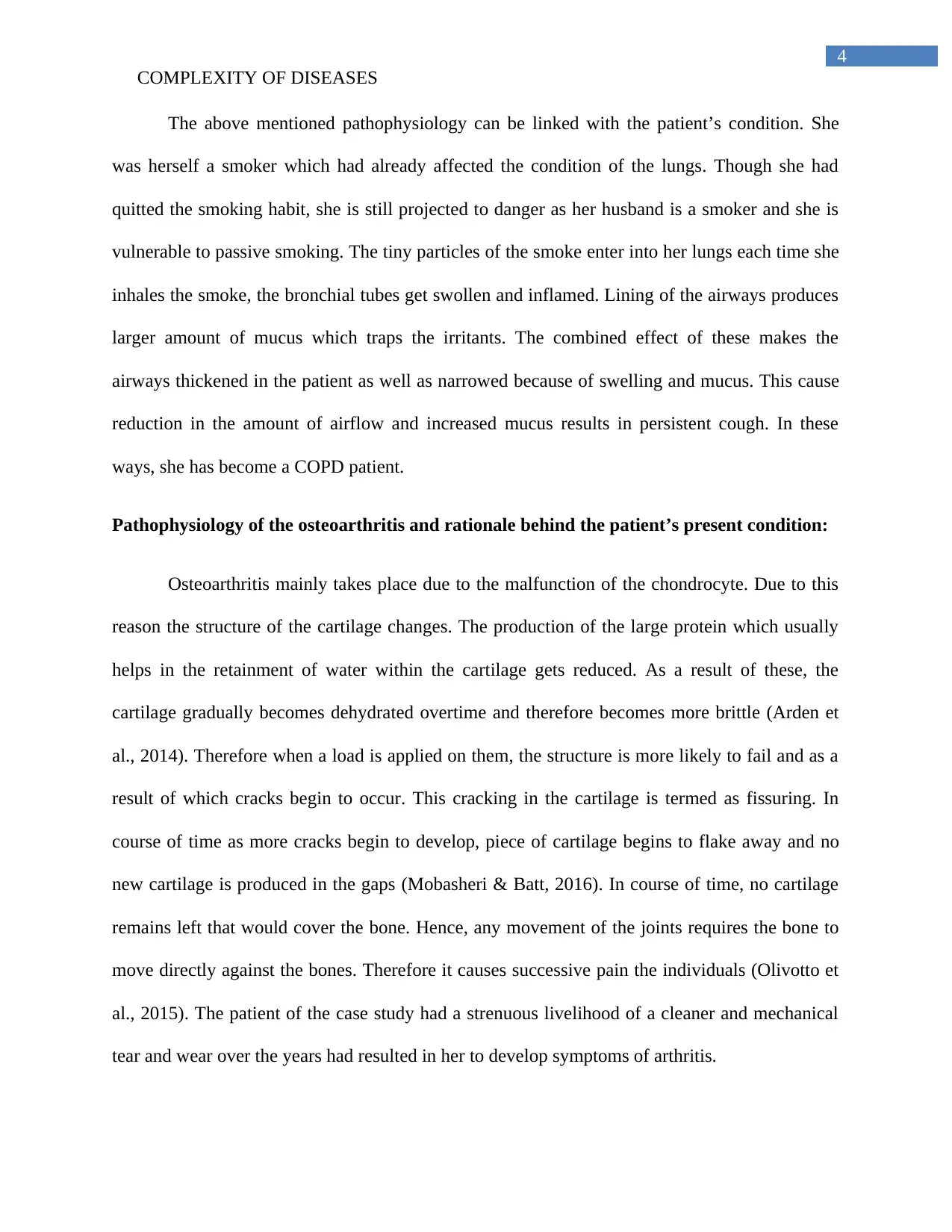
4
COMPLEXITY OF DISEASES
The above mentioned pathophysiology can be linked with the patient’s condition. She
was herself a smoker which had already affected the condition of the lungs. Though she had
quitted the smoking habit, she is still projected to danger as her husband is a smoker and she is
vulnerable to passive smoking. The tiny particles of the smoke enter into her lungs each time she
inhales the smoke, the bronchial tubes get swollen and inflamed. Lining of the airways produces
larger amount of mucus which traps the irritants. The combined effect of these makes the
airways thickened in the patient as well as narrowed because of swelling and mucus. This cause
reduction in the amount of airflow and increased mucus results in persistent cough. In these
ways, she has become a COPD patient.
Pathophysiology of the osteoarthritis and rationale behind the patient’s present condition:
Osteoarthritis mainly takes place due to the malfunction of the chondrocyte. Due to this
reason the structure of the cartilage changes. The production of the large protein which usually
helps in the retainment of water within the cartilage gets reduced. As a result of these, the
cartilage gradually becomes dehydrated overtime and therefore becomes more brittle (Arden et
al., 2014). Therefore when a load is applied on them, the structure is more likely to fail and as a
result of which cracks begin to occur. This cracking in the cartilage is termed as fissuring. In
course of time as more cracks begin to develop, piece of cartilage begins to flake away and no
new cartilage is produced in the gaps (Mobasheri & Batt, 2016). In course of time, no cartilage
remains left that would cover the bone. Hence, any movement of the joints requires the bone to
move directly against the bones. Therefore it causes successive pain the individuals (Olivotto et
al., 2015). The patient of the case study had a strenuous livelihood of a cleaner and mechanical
tear and wear over the years had resulted in her to develop symptoms of arthritis.
COMPLEXITY OF DISEASES
The above mentioned pathophysiology can be linked with the patient’s condition. She
was herself a smoker which had already affected the condition of the lungs. Though she had
quitted the smoking habit, she is still projected to danger as her husband is a smoker and she is
vulnerable to passive smoking. The tiny particles of the smoke enter into her lungs each time she
inhales the smoke, the bronchial tubes get swollen and inflamed. Lining of the airways produces
larger amount of mucus which traps the irritants. The combined effect of these makes the
airways thickened in the patient as well as narrowed because of swelling and mucus. This cause
reduction in the amount of airflow and increased mucus results in persistent cough. In these
ways, she has become a COPD patient.
Pathophysiology of the osteoarthritis and rationale behind the patient’s present condition:
Osteoarthritis mainly takes place due to the malfunction of the chondrocyte. Due to this
reason the structure of the cartilage changes. The production of the large protein which usually
helps in the retainment of water within the cartilage gets reduced. As a result of these, the
cartilage gradually becomes dehydrated overtime and therefore becomes more brittle (Arden et
al., 2014). Therefore when a load is applied on them, the structure is more likely to fail and as a
result of which cracks begin to occur. This cracking in the cartilage is termed as fissuring. In
course of time as more cracks begin to develop, piece of cartilage begins to flake away and no
new cartilage is produced in the gaps (Mobasheri & Batt, 2016). In course of time, no cartilage
remains left that would cover the bone. Hence, any movement of the joints requires the bone to
move directly against the bones. Therefore it causes successive pain the individuals (Olivotto et
al., 2015). The patient of the case study had a strenuous livelihood of a cleaner and mechanical
tear and wear over the years had resulted in her to develop symptoms of arthritis.
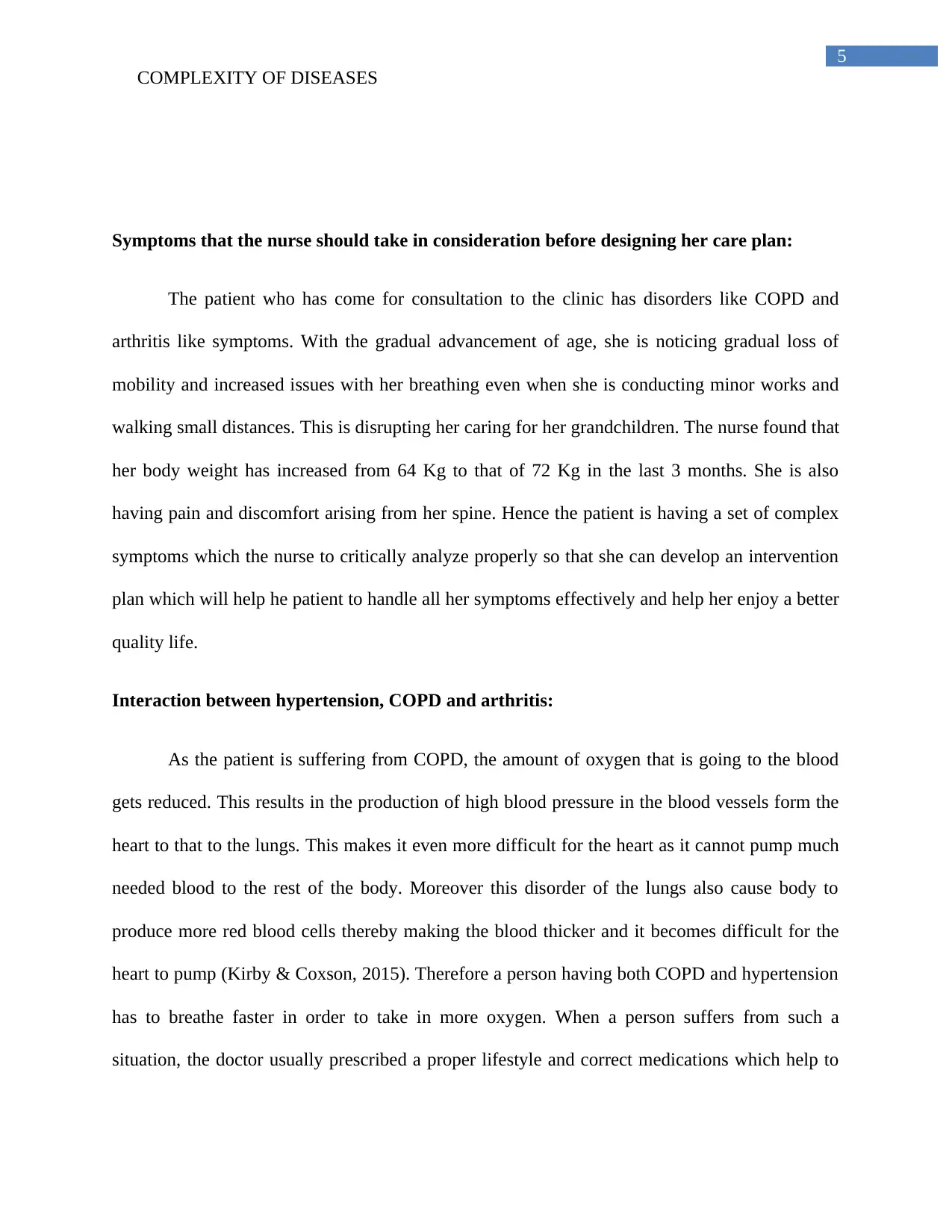
5
COMPLEXITY OF DISEASES
Symptoms that the nurse should take in consideration before designing her care plan:
The patient who has come for consultation to the clinic has disorders like COPD and
arthritis like symptoms. With the gradual advancement of age, she is noticing gradual loss of
mobility and increased issues with her breathing even when she is conducting minor works and
walking small distances. This is disrupting her caring for her grandchildren. The nurse found that
her body weight has increased from 64 Kg to that of 72 Kg in the last 3 months. She is also
having pain and discomfort arising from her spine. Hence the patient is having a set of complex
symptoms which the nurse to critically analyze properly so that she can develop an intervention
plan which will help he patient to handle all her symptoms effectively and help her enjoy a better
quality life.
Interaction between hypertension, COPD and arthritis:
As the patient is suffering from COPD, the amount of oxygen that is going to the blood
gets reduced. This results in the production of high blood pressure in the blood vessels form the
heart to that to the lungs. This makes it even more difficult for the heart as it cannot pump much
needed blood to the rest of the body. Moreover this disorder of the lungs also cause body to
produce more red blood cells thereby making the blood thicker and it becomes difficult for the
heart to pump (Kirby & Coxson, 2015). Therefore a person having both COPD and hypertension
has to breathe faster in order to take in more oxygen. When a person suffers from such a
situation, the doctor usually prescribed a proper lifestyle and correct medications which help to
COMPLEXITY OF DISEASES
Symptoms that the nurse should take in consideration before designing her care plan:
The patient who has come for consultation to the clinic has disorders like COPD and
arthritis like symptoms. With the gradual advancement of age, she is noticing gradual loss of
mobility and increased issues with her breathing even when she is conducting minor works and
walking small distances. This is disrupting her caring for her grandchildren. The nurse found that
her body weight has increased from 64 Kg to that of 72 Kg in the last 3 months. She is also
having pain and discomfort arising from her spine. Hence the patient is having a set of complex
symptoms which the nurse to critically analyze properly so that she can develop an intervention
plan which will help he patient to handle all her symptoms effectively and help her enjoy a better
quality life.
Interaction between hypertension, COPD and arthritis:
As the patient is suffering from COPD, the amount of oxygen that is going to the blood
gets reduced. This results in the production of high blood pressure in the blood vessels form the
heart to that to the lungs. This makes it even more difficult for the heart as it cannot pump much
needed blood to the rest of the body. Moreover this disorder of the lungs also cause body to
produce more red blood cells thereby making the blood thicker and it becomes difficult for the
heart to pump (Kirby & Coxson, 2015). Therefore a person having both COPD and hypertension
has to breathe faster in order to take in more oxygen. When a person suffers from such a
situation, the doctor usually prescribed a proper lifestyle and correct medications which help to
⊘ This is a preview!⊘
Do you want full access?
Subscribe today to unlock all pages.

Trusted by 1+ million students worldwide
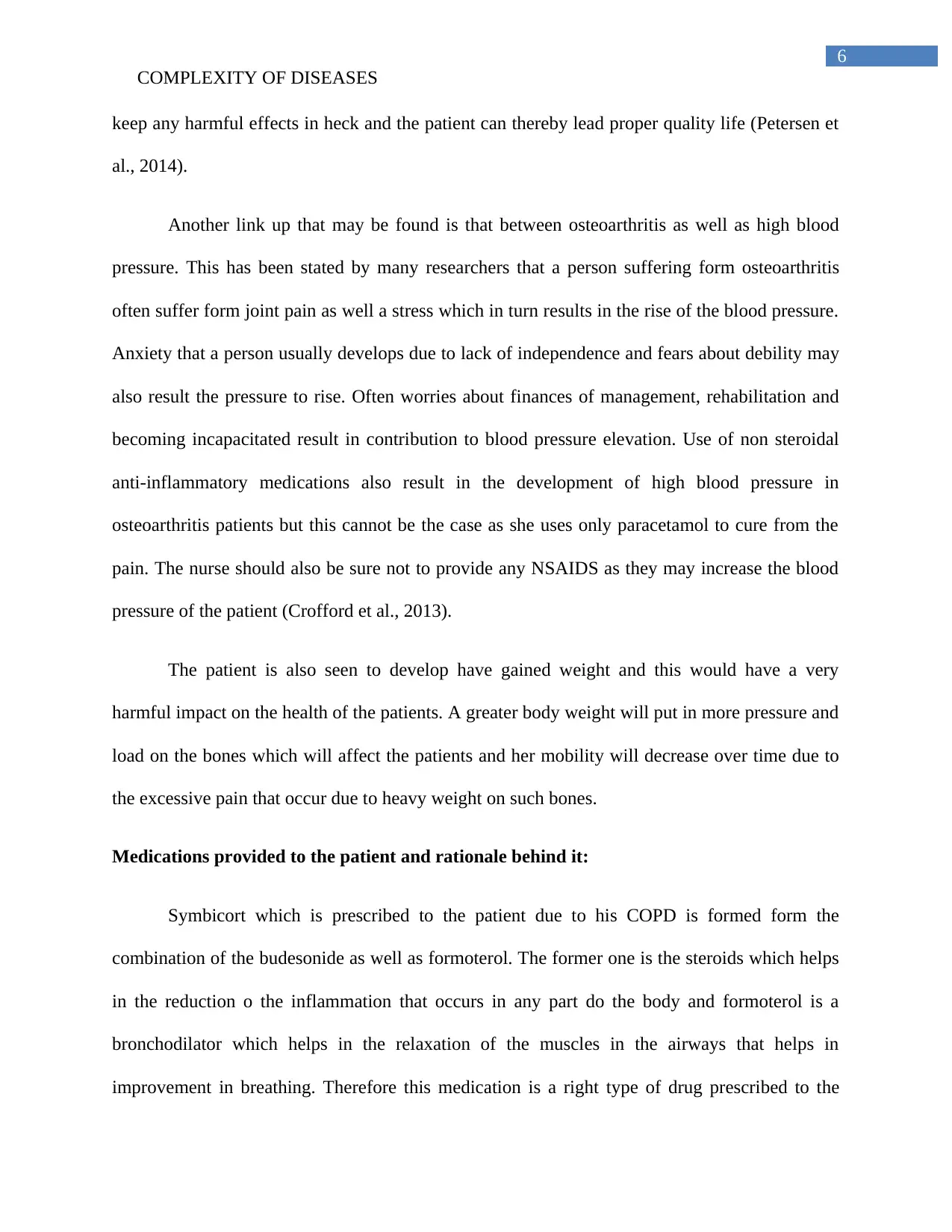
6
COMPLEXITY OF DISEASES
keep any harmful effects in heck and the patient can thereby lead proper quality life (Petersen et
al., 2014).
Another link up that may be found is that between osteoarthritis as well as high blood
pressure. This has been stated by many researchers that a person suffering form osteoarthritis
often suffer form joint pain as well a stress which in turn results in the rise of the blood pressure.
Anxiety that a person usually develops due to lack of independence and fears about debility may
also result the pressure to rise. Often worries about finances of management, rehabilitation and
becoming incapacitated result in contribution to blood pressure elevation. Use of non steroidal
anti-inflammatory medications also result in the development of high blood pressure in
osteoarthritis patients but this cannot be the case as she uses only paracetamol to cure from the
pain. The nurse should also be sure not to provide any NSAIDS as they may increase the blood
pressure of the patient (Crofford et al., 2013).
The patient is also seen to develop have gained weight and this would have a very
harmful impact on the health of the patients. A greater body weight will put in more pressure and
load on the bones which will affect the patients and her mobility will decrease over time due to
the excessive pain that occur due to heavy weight on such bones.
Medications provided to the patient and rationale behind it:
Symbicort which is prescribed to the patient due to his COPD is formed form the
combination of the budesonide as well as formoterol. The former one is the steroids which helps
in the reduction o the inflammation that occurs in any part do the body and formoterol is a
bronchodilator which helps in the relaxation of the muscles in the airways that helps in
improvement in breathing. Therefore this medication is a right type of drug prescribed to the
COMPLEXITY OF DISEASES
keep any harmful effects in heck and the patient can thereby lead proper quality life (Petersen et
al., 2014).
Another link up that may be found is that between osteoarthritis as well as high blood
pressure. This has been stated by many researchers that a person suffering form osteoarthritis
often suffer form joint pain as well a stress which in turn results in the rise of the blood pressure.
Anxiety that a person usually develops due to lack of independence and fears about debility may
also result the pressure to rise. Often worries about finances of management, rehabilitation and
becoming incapacitated result in contribution to blood pressure elevation. Use of non steroidal
anti-inflammatory medications also result in the development of high blood pressure in
osteoarthritis patients but this cannot be the case as she uses only paracetamol to cure from the
pain. The nurse should also be sure not to provide any NSAIDS as they may increase the blood
pressure of the patient (Crofford et al., 2013).
The patient is also seen to develop have gained weight and this would have a very
harmful impact on the health of the patients. A greater body weight will put in more pressure and
load on the bones which will affect the patients and her mobility will decrease over time due to
the excessive pain that occur due to heavy weight on such bones.
Medications provided to the patient and rationale behind it:
Symbicort which is prescribed to the patient due to his COPD is formed form the
combination of the budesonide as well as formoterol. The former one is the steroids which helps
in the reduction o the inflammation that occurs in any part do the body and formoterol is a
bronchodilator which helps in the relaxation of the muscles in the airways that helps in
improvement in breathing. Therefore this medication is a right type of drug prescribed to the
Paraphrase This Document
Need a fresh take? Get an instant paraphrase of this document with our AI Paraphraser
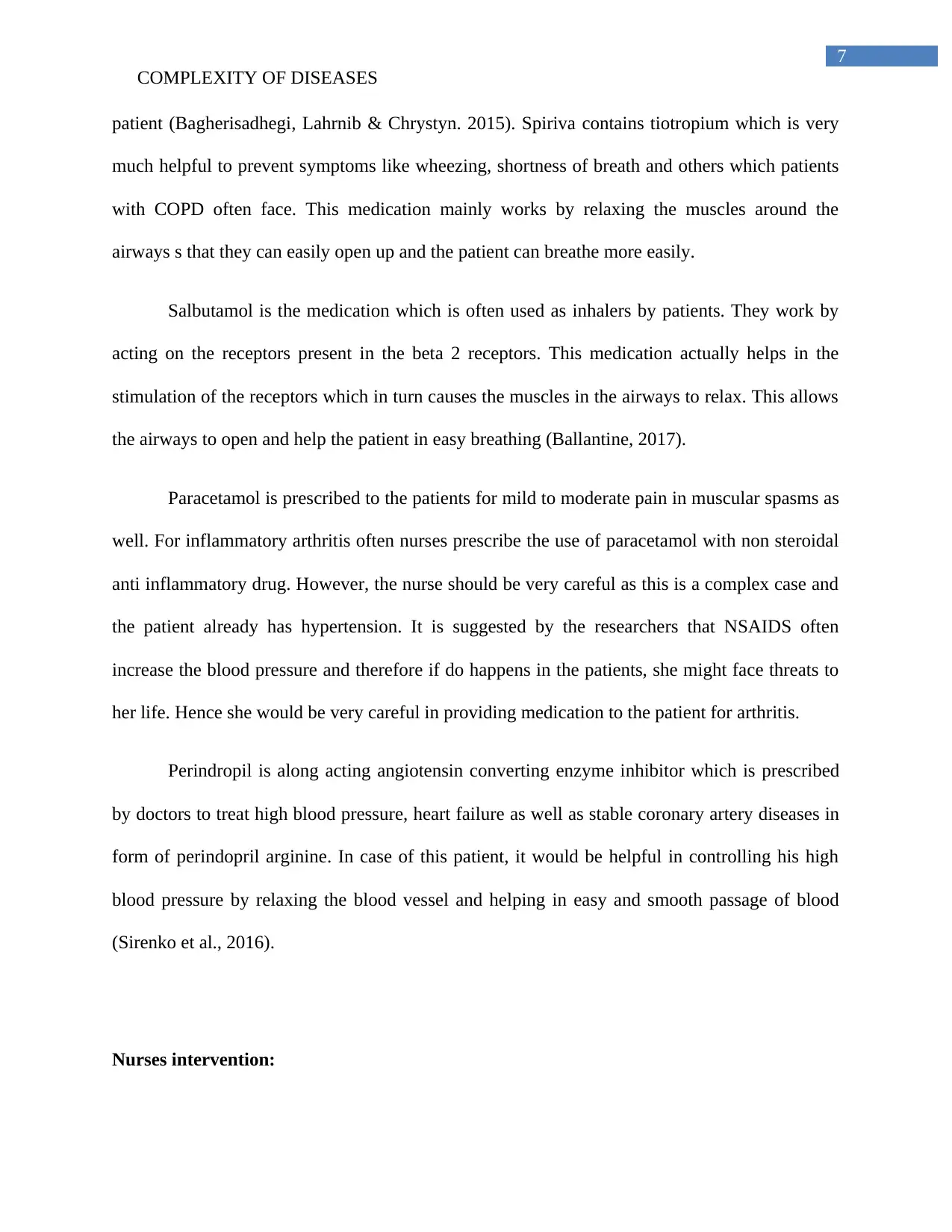
7
COMPLEXITY OF DISEASES
patient (Bagherisadhegi, Lahrnib & Chrystyn. 2015). Spiriva contains tiotropium which is very
much helpful to prevent symptoms like wheezing, shortness of breath and others which patients
with COPD often face. This medication mainly works by relaxing the muscles around the
airways s that they can easily open up and the patient can breathe more easily.
Salbutamol is the medication which is often used as inhalers by patients. They work by
acting on the receptors present in the beta 2 receptors. This medication actually helps in the
stimulation of the receptors which in turn causes the muscles in the airways to relax. This allows
the airways to open and help the patient in easy breathing (Ballantine, 2017).
Paracetamol is prescribed to the patients for mild to moderate pain in muscular spasms as
well. For inflammatory arthritis often nurses prescribe the use of paracetamol with non steroidal
anti inflammatory drug. However, the nurse should be very careful as this is a complex case and
the patient already has hypertension. It is suggested by the researchers that NSAIDS often
increase the blood pressure and therefore if do happens in the patients, she might face threats to
her life. Hence she would be very careful in providing medication to the patient for arthritis.
Perindropil is along acting angiotensin converting enzyme inhibitor which is prescribed
by doctors to treat high blood pressure, heart failure as well as stable coronary artery diseases in
form of perindopril arginine. In case of this patient, it would be helpful in controlling his high
blood pressure by relaxing the blood vessel and helping in easy and smooth passage of blood
(Sirenko et al., 2016).
Nurses intervention:
COMPLEXITY OF DISEASES
patient (Bagherisadhegi, Lahrnib & Chrystyn. 2015). Spiriva contains tiotropium which is very
much helpful to prevent symptoms like wheezing, shortness of breath and others which patients
with COPD often face. This medication mainly works by relaxing the muscles around the
airways s that they can easily open up and the patient can breathe more easily.
Salbutamol is the medication which is often used as inhalers by patients. They work by
acting on the receptors present in the beta 2 receptors. This medication actually helps in the
stimulation of the receptors which in turn causes the muscles in the airways to relax. This allows
the airways to open and help the patient in easy breathing (Ballantine, 2017).
Paracetamol is prescribed to the patients for mild to moderate pain in muscular spasms as
well. For inflammatory arthritis often nurses prescribe the use of paracetamol with non steroidal
anti inflammatory drug. However, the nurse should be very careful as this is a complex case and
the patient already has hypertension. It is suggested by the researchers that NSAIDS often
increase the blood pressure and therefore if do happens in the patients, she might face threats to
her life. Hence she would be very careful in providing medication to the patient for arthritis.
Perindropil is along acting angiotensin converting enzyme inhibitor which is prescribed
by doctors to treat high blood pressure, heart failure as well as stable coronary artery diseases in
form of perindopril arginine. In case of this patient, it would be helpful in controlling his high
blood pressure by relaxing the blood vessel and helping in easy and smooth passage of blood
(Sirenko et al., 2016).
Nurses intervention:
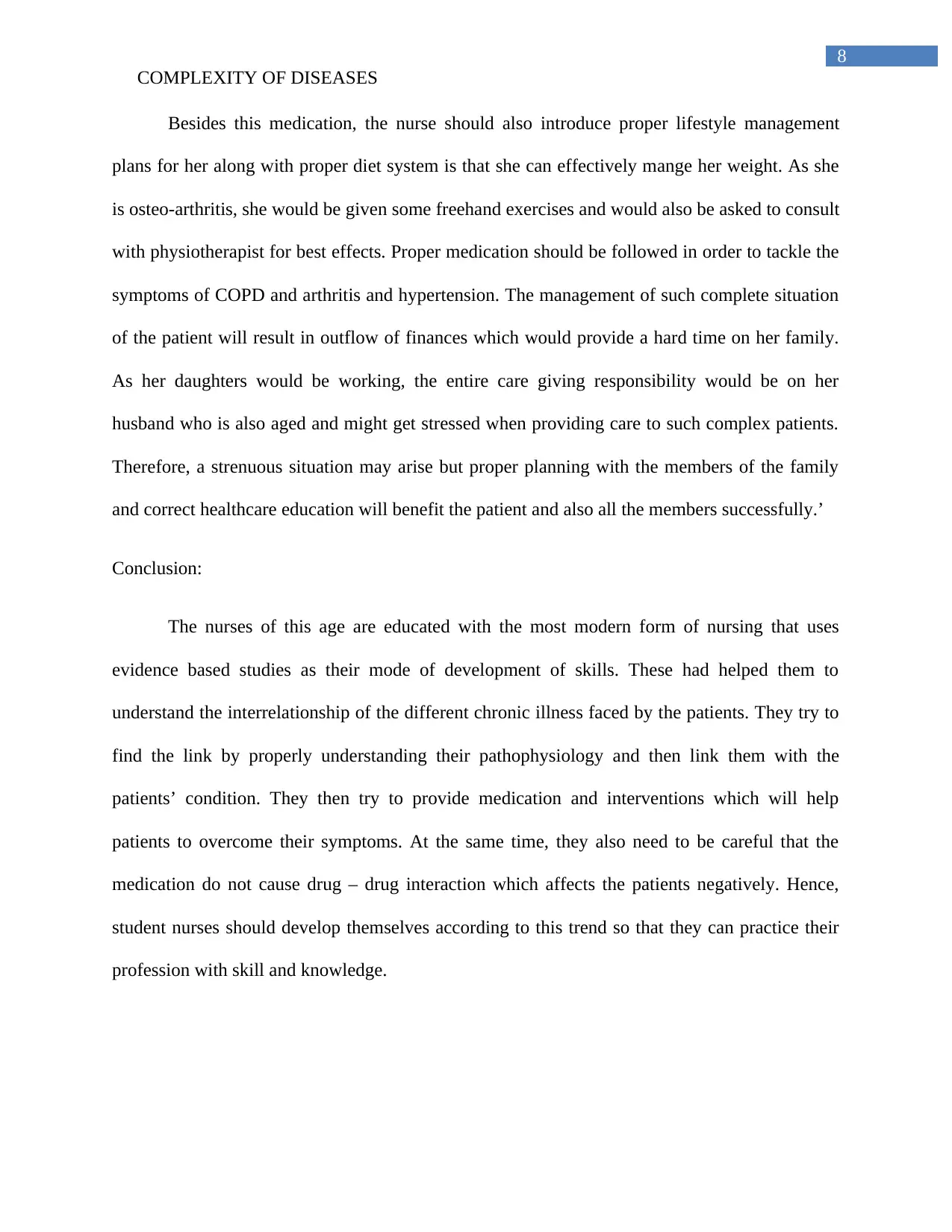
8
COMPLEXITY OF DISEASES
Besides this medication, the nurse should also introduce proper lifestyle management
plans for her along with proper diet system is that she can effectively mange her weight. As she
is osteo-arthritis, she would be given some freehand exercises and would also be asked to consult
with physiotherapist for best effects. Proper medication should be followed in order to tackle the
symptoms of COPD and arthritis and hypertension. The management of such complete situation
of the patient will result in outflow of finances which would provide a hard time on her family.
As her daughters would be working, the entire care giving responsibility would be on her
husband who is also aged and might get stressed when providing care to such complex patients.
Therefore, a strenuous situation may arise but proper planning with the members of the family
and correct healthcare education will benefit the patient and also all the members successfully.’
Conclusion:
The nurses of this age are educated with the most modern form of nursing that uses
evidence based studies as their mode of development of skills. These had helped them to
understand the interrelationship of the different chronic illness faced by the patients. They try to
find the link by properly understanding their pathophysiology and then link them with the
patients’ condition. They then try to provide medication and interventions which will help
patients to overcome their symptoms. At the same time, they also need to be careful that the
medication do not cause drug – drug interaction which affects the patients negatively. Hence,
student nurses should develop themselves according to this trend so that they can practice their
profession with skill and knowledge.
COMPLEXITY OF DISEASES
Besides this medication, the nurse should also introduce proper lifestyle management
plans for her along with proper diet system is that she can effectively mange her weight. As she
is osteo-arthritis, she would be given some freehand exercises and would also be asked to consult
with physiotherapist for best effects. Proper medication should be followed in order to tackle the
symptoms of COPD and arthritis and hypertension. The management of such complete situation
of the patient will result in outflow of finances which would provide a hard time on her family.
As her daughters would be working, the entire care giving responsibility would be on her
husband who is also aged and might get stressed when providing care to such complex patients.
Therefore, a strenuous situation may arise but proper planning with the members of the family
and correct healthcare education will benefit the patient and also all the members successfully.’
Conclusion:
The nurses of this age are educated with the most modern form of nursing that uses
evidence based studies as their mode of development of skills. These had helped them to
understand the interrelationship of the different chronic illness faced by the patients. They try to
find the link by properly understanding their pathophysiology and then link them with the
patients’ condition. They then try to provide medication and interventions which will help
patients to overcome their symptoms. At the same time, they also need to be careful that the
medication do not cause drug – drug interaction which affects the patients negatively. Hence,
student nurses should develop themselves according to this trend so that they can practice their
profession with skill and knowledge.
⊘ This is a preview!⊘
Do you want full access?
Subscribe today to unlock all pages.

Trusted by 1+ million students worldwide
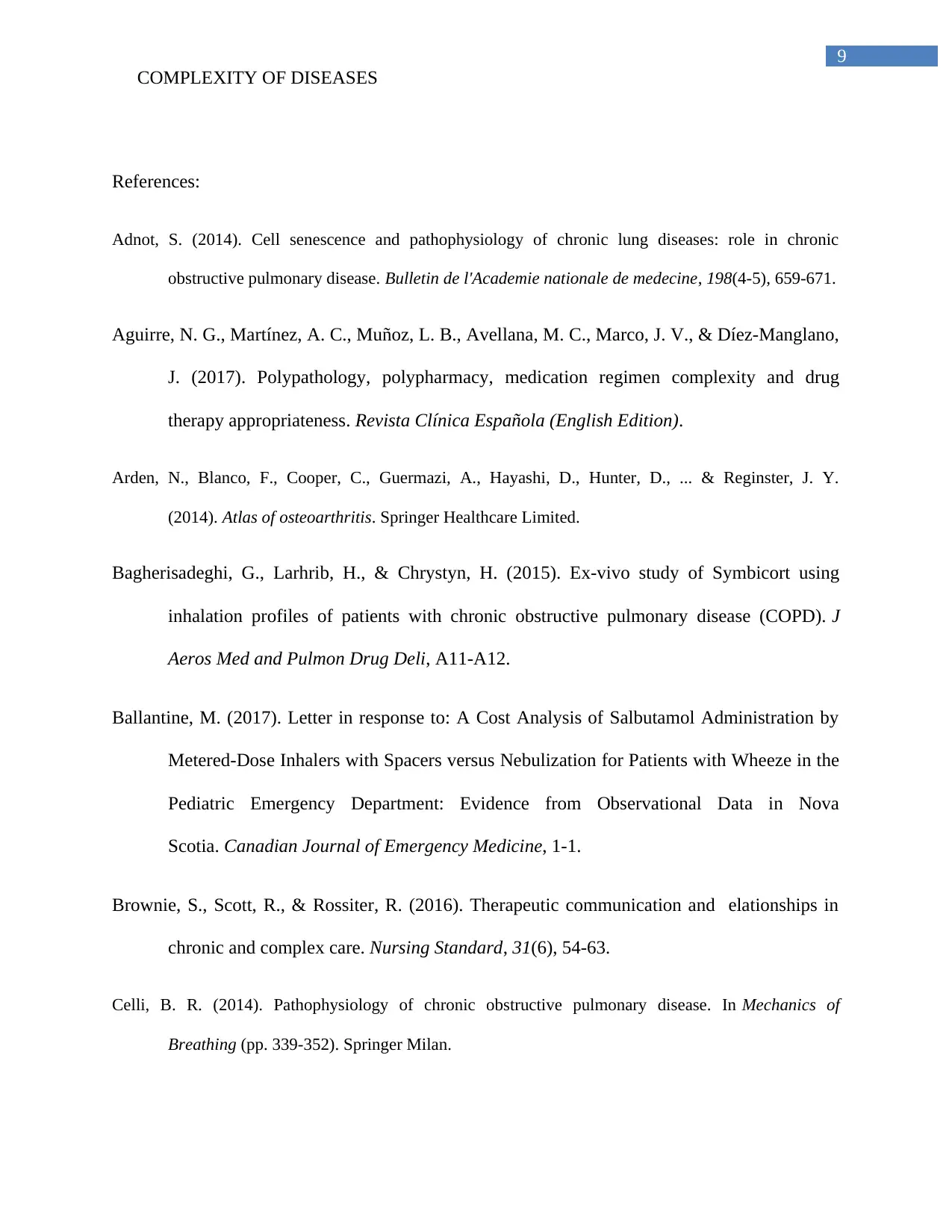
9
COMPLEXITY OF DISEASES
References:
Adnot, S. (2014). Cell senescence and pathophysiology of chronic lung diseases: role in chronic
obstructive pulmonary disease. Bulletin de l'Academie nationale de medecine, 198(4-5), 659-671.
Aguirre, N. G., Martínez, A. C., Muñoz, L. B., Avellana, M. C., Marco, J. V., & Díez-Manglano,
J. (2017). Polypathology, polypharmacy, medication regimen complexity and drug
therapy appropriateness. Revista Clínica Española (English Edition).
Arden, N., Blanco, F., Cooper, C., Guermazi, A., Hayashi, D., Hunter, D., ... & Reginster, J. Y.
(2014). Atlas of osteoarthritis. Springer Healthcare Limited.
Bagherisadeghi, G., Larhrib, H., & Chrystyn, H. (2015). Ex-vivo study of Symbicort using
inhalation profiles of patients with chronic obstructive pulmonary disease (COPD). J
Aeros Med and Pulmon Drug Deli, A11-A12.
Ballantine, M. (2017). Letter in response to: A Cost Analysis of Salbutamol Administration by
Metered-Dose Inhalers with Spacers versus Nebulization for Patients with Wheeze in the
Pediatric Emergency Department: Evidence from Observational Data in Nova
Scotia. Canadian Journal of Emergency Medicine, 1-1.
Brownie, S., Scott, R., & Rossiter, R. (2016). Therapeutic communication and elationships in
chronic and complex care. Nursing Standard, 31(6), 54-63.
Celli, B. R. (2014). Pathophysiology of chronic obstructive pulmonary disease. In Mechanics of
Breathing (pp. 339-352). Springer Milan.
COMPLEXITY OF DISEASES
References:
Adnot, S. (2014). Cell senescence and pathophysiology of chronic lung diseases: role in chronic
obstructive pulmonary disease. Bulletin de l'Academie nationale de medecine, 198(4-5), 659-671.
Aguirre, N. G., Martínez, A. C., Muñoz, L. B., Avellana, M. C., Marco, J. V., & Díez-Manglano,
J. (2017). Polypathology, polypharmacy, medication regimen complexity and drug
therapy appropriateness. Revista Clínica Española (English Edition).
Arden, N., Blanco, F., Cooper, C., Guermazi, A., Hayashi, D., Hunter, D., ... & Reginster, J. Y.
(2014). Atlas of osteoarthritis. Springer Healthcare Limited.
Bagherisadeghi, G., Larhrib, H., & Chrystyn, H. (2015). Ex-vivo study of Symbicort using
inhalation profiles of patients with chronic obstructive pulmonary disease (COPD). J
Aeros Med and Pulmon Drug Deli, A11-A12.
Ballantine, M. (2017). Letter in response to: A Cost Analysis of Salbutamol Administration by
Metered-Dose Inhalers with Spacers versus Nebulization for Patients with Wheeze in the
Pediatric Emergency Department: Evidence from Observational Data in Nova
Scotia. Canadian Journal of Emergency Medicine, 1-1.
Brownie, S., Scott, R., & Rossiter, R. (2016). Therapeutic communication and elationships in
chronic and complex care. Nursing Standard, 31(6), 54-63.
Celli, B. R. (2014). Pathophysiology of chronic obstructive pulmonary disease. In Mechanics of
Breathing (pp. 339-352). Springer Milan.
Paraphrase This Document
Need a fresh take? Get an instant paraphrase of this document with our AI Paraphraser
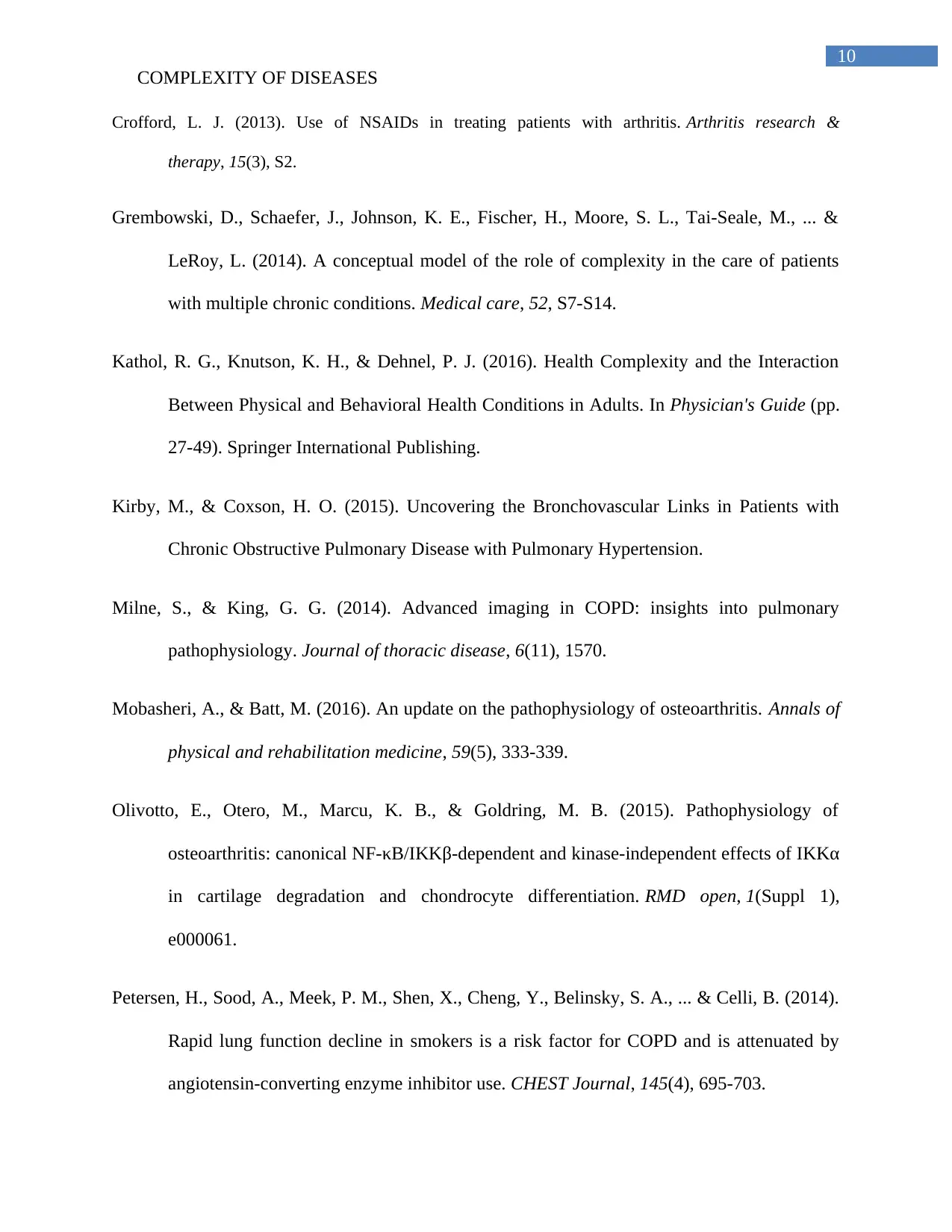
10
COMPLEXITY OF DISEASES
Crofford, L. J. (2013). Use of NSAIDs in treating patients with arthritis. Arthritis research &
therapy, 15(3), S2.
Grembowski, D., Schaefer, J., Johnson, K. E., Fischer, H., Moore, S. L., Tai-Seale, M., ... &
LeRoy, L. (2014). A conceptual model of the role of complexity in the care of patients
with multiple chronic conditions. Medical care, 52, S7-S14.
Kathol, R. G., Knutson, K. H., & Dehnel, P. J. (2016). Health Complexity and the Interaction
Between Physical and Behavioral Health Conditions in Adults. In Physician's Guide (pp.
27-49). Springer International Publishing.
Kirby, M., & Coxson, H. O. (2015). Uncovering the Bronchovascular Links in Patients with
Chronic Obstructive Pulmonary Disease with Pulmonary Hypertension.
Milne, S., & King, G. G. (2014). Advanced imaging in COPD: insights into pulmonary
pathophysiology. Journal of thoracic disease, 6(11), 1570.
Mobasheri, A., & Batt, M. (2016). An update on the pathophysiology of osteoarthritis. Annals of
physical and rehabilitation medicine, 59(5), 333-339.
Olivotto, E., Otero, M., Marcu, K. B., & Goldring, M. B. (2015). Pathophysiology of
osteoarthritis: canonical NF-κB/IKKβ-dependent and kinase-independent effects of IKKα
in cartilage degradation and chondrocyte differentiation. RMD open, 1(Suppl 1),
e000061.
Petersen, H., Sood, A., Meek, P. M., Shen, X., Cheng, Y., Belinsky, S. A., ... & Celli, B. (2014).
Rapid lung function decline in smokers is a risk factor for COPD and is attenuated by
angiotensin-converting enzyme inhibitor use. CHEST Journal, 145(4), 695-703.
COMPLEXITY OF DISEASES
Crofford, L. J. (2013). Use of NSAIDs in treating patients with arthritis. Arthritis research &
therapy, 15(3), S2.
Grembowski, D., Schaefer, J., Johnson, K. E., Fischer, H., Moore, S. L., Tai-Seale, M., ... &
LeRoy, L. (2014). A conceptual model of the role of complexity in the care of patients
with multiple chronic conditions. Medical care, 52, S7-S14.
Kathol, R. G., Knutson, K. H., & Dehnel, P. J. (2016). Health Complexity and the Interaction
Between Physical and Behavioral Health Conditions in Adults. In Physician's Guide (pp.
27-49). Springer International Publishing.
Kirby, M., & Coxson, H. O. (2015). Uncovering the Bronchovascular Links in Patients with
Chronic Obstructive Pulmonary Disease with Pulmonary Hypertension.
Milne, S., & King, G. G. (2014). Advanced imaging in COPD: insights into pulmonary
pathophysiology. Journal of thoracic disease, 6(11), 1570.
Mobasheri, A., & Batt, M. (2016). An update on the pathophysiology of osteoarthritis. Annals of
physical and rehabilitation medicine, 59(5), 333-339.
Olivotto, E., Otero, M., Marcu, K. B., & Goldring, M. B. (2015). Pathophysiology of
osteoarthritis: canonical NF-κB/IKKβ-dependent and kinase-independent effects of IKKα
in cartilage degradation and chondrocyte differentiation. RMD open, 1(Suppl 1),
e000061.
Petersen, H., Sood, A., Meek, P. M., Shen, X., Cheng, Y., Belinsky, S. A., ... & Celli, B. (2014).
Rapid lung function decline in smokers is a risk factor for COPD and is attenuated by
angiotensin-converting enzyme inhibitor use. CHEST Journal, 145(4), 695-703.

11
COMPLEXITY OF DISEASES
Sirenko, Y. M., Rekovets, O. L., Kushnir, S. M., & Torbas, O. O. (2016). Comparative Efficiency of
Enalapril and Perindopril in Terms of the Effect on Central Blood Pressure and Elastic Properties
of Arteries in Patients with Mild to Moderate Hypertension. HYPERTENSION, (2.46), 101-112.
COMPLEXITY OF DISEASES
Sirenko, Y. M., Rekovets, O. L., Kushnir, S. M., & Torbas, O. O. (2016). Comparative Efficiency of
Enalapril and Perindopril in Terms of the Effect on Central Blood Pressure and Elastic Properties
of Arteries in Patients with Mild to Moderate Hypertension. HYPERTENSION, (2.46), 101-112.
⊘ This is a preview!⊘
Do you want full access?
Subscribe today to unlock all pages.

Trusted by 1+ million students worldwide
1 out of 12
Related Documents
Your All-in-One AI-Powered Toolkit for Academic Success.
+13062052269
info@desklib.com
Available 24*7 on WhatsApp / Email
![[object Object]](/_next/static/media/star-bottom.7253800d.svg)
Unlock your academic potential
Copyright © 2020–2025 A2Z Services. All Rights Reserved. Developed and managed by ZUCOL.





